A bispecific antibody (BsAb) is a type of artificial protein with the ability to bind to two distinct antigens or two epitopes of one antigen at the same time. Bispecific antibodies can assume a synergistic role of the two monoclonal antibodies and have benefits over the simple combination.
Due to its special biological mechanism, the bispecific antibody has turned out to be an essential branch of therapeutic antibody research and development and has been drawing investments. As per statistics, there are over 180 bispecific antibodies in clinical trials and nearly 260 in pre-clinical development around the world. Among them, CD3 is considered to be the primary target.
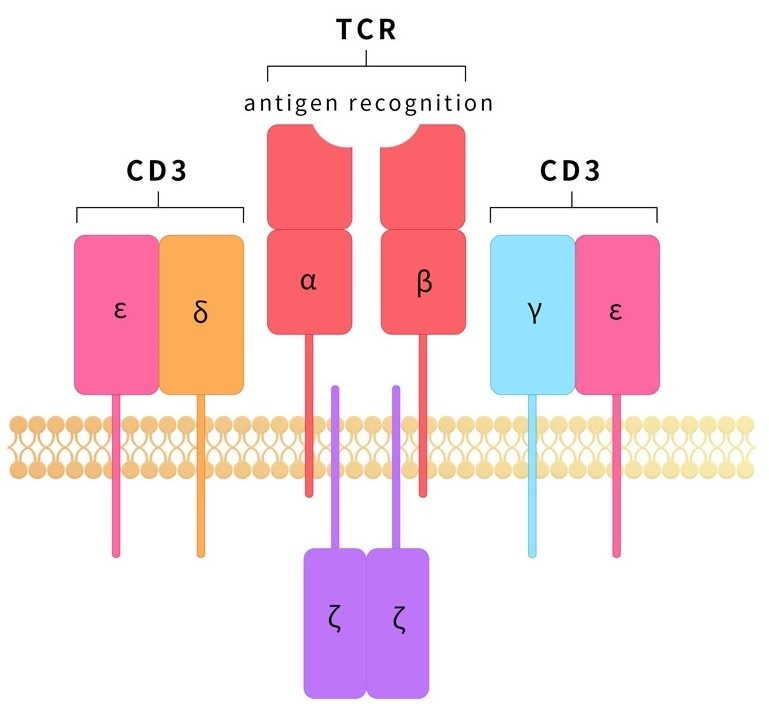
Image Credit: ACROBiosystems
CD3 molecules tend to bind to TCR non-covalently to develop a TCR/CD3 receptor complex on the T-cell’s surface. There are four subtypes of CD3 — CD3ε, CD3δ, CD3γ and CD3ζ. CD3δ/CD3ε and CD3γ/CD3ε have the ability to develop the TCR-CD3 complexes through the α/β chain of TCR as heterodimers.
Generally, CD3-targeted therapeutic antibodies recognize the CD3ε in the heterodimer complex to initiate the anti-tumor activity of T cells. But during recombinant expression, CD3E and CD3D have the ability to randomly form faulty heterogeneous complexes, which might result in the loss of bioactivity and huge batch-to-batch inconsistency.
ACROBiosystems has designed a range of homogeneous CD3δ/CD3ε and CD3γ/CD3ε proteins with good bioactivity. They are confirmed as 1:1 heterodimers by non-reductive electrophoresis and MALS as well.
In addition, they exhibit superior performance in therapeutic antibody screening, identification, characterization as well as clinical pharmacokinetic assays, etc. Furthermore, the CD3 products have been successfully utilized for the clinical development of a bispecific antibody. This greatly expedited the process of therapeutic antibody development.
Product features
- MALS verified heterodimer
- Bioactivity confirmed by a clinical bispecific antibody
- Various tags: his, his&Avi, Fc tags, etc.
- High binding ability and low batch-to-batch variations
Product list
CD3E and CD3D
Table 1. Source: ACROBiosystems
| Molecule |
Cat. No. |
Species |
Product Description |
Structure |
| CD3E & CD3D |
CDD-H5255 |
HEK293 |
Human CD3 epsilon&CD3 delta Heterodimer Protein, Fc Tag
&Fc Tag (MALS verified)New |
|
| CDD-H52Wa |
HEK293 |
Human CD3 epsilon&CD3 delta Heterodimer Protein, Fc, His Tag&Fc, Flag Tag (MALS verified)Hot |
|
| CDD-H82W6 |
HEK293 |
Biotinylated Human CD3 epsilon&CD3 delta Heterodimer Protein, His, Avitag™&Tag Free (MALS verified)Hot |
|
| CDD-H52W1 |
HEK293 |
Human CD3 epsilon & CD3 delta Heterodimer Protein, His Tag&Tag Free (MALS verified)Hot |
|
Click here to learn about many more CD3E and CD3Ds.
CD3E and CD3G
Table 2. Source: ACROBiosystems
| Molecule |
Cat. No. |
Host |
Product Description |
Structure |
| CD3E & CD3G |
CDG-H5253 |
HEK293 |
Human CD3 epsilon&CD3 gamma Heterodimer Protein, Fc Tag
&Fc Tag (MALS verified)New |
|
| CDG-H52W9 |
HEK293 |
Human CD3 epsilon&CD3 gamma Heterodimer Protein, Fc, His Tag&Fc, Flag Tag (MALS verified)Hot |
|
| CDG-H52W5 |
HEK293 |
Human CD3 epsilon&CD3 gamma Heterodimer Protein, His Tag&Tag Free (MALS verified) |
|
| CDG-C5257 |
HEK293 |
Cynomolgus CD3E&CD3G Heterodimer Protein, Fc Tag&Fc Tag (MALS verified) |
|
Click here to learn about many more CD3E and CD3Gs.
CD3 epsilon
Table 3. Source: ACROBiosystems
| Molecule |
Cat. No. |
Host |
Product Description |
Structure |
CD3
epsilon |
CDE-M525a |
HEK293 |
Biotinylated Monoclonal Anti-Human CD3 Antibody, Mouse IgG2a, Avitag™ (Clone: OKT3), Ultra-low endotoxin |
|
| CDE-H5223 |
HEK293 |
Human CD3 epsilon Protein, His Tag (MALS verified)Hot |
|
| CDE-H5256 |
HEK293 |
Human CD3 epsilon Protein, Fc, His TagHot |
|
| CDE-C5226 |
HEK293 |
Cynomolgus CD3 epsilon Protein, His Tag (MALS verified)Hot |
|
Click here to learn about many more CD3 epsilons.
CD3 delta
Table 4. Source: ACROBiosystems
| Molecule |
Cat. No. |
Host |
Product Description |
Structure |
| CD3 delta |
CDD-H5224 |
HEK293 |
Human CD3 delta Protein, His Tag |
|
| CDD-C52H8 |
HEK293 |
Cynomolgus CD3 delta Protein, His Tag |
|
CD3 gamma
Table 5. Source: ACROBiosystems
| Molecule |
Cat. No. |
Host |
Product Description |
Structure |
CD3
gamma |
CDA-H5254 |
HEK293 |
Human CD3 gamma / CD3G Protein, Fc Tag (MALS verified) |
|
More BsAb targets
Table 6. Source: ACROBiosystems
| . |
| CD19 |
CD20 |
CD38 |
CD40 |
CD47 |
| IL-3 R alpha |
Her2 |
ErbB3 |
LAG-3 |
4-1BB |
| PD-1 |
PD-L1 |
CTLA-4 |
TIM-3 |
EpCAM |
| EGF R |
BCMA |
PSMA |
HGF R |
ROR1 |
| VEGF R2 |
FAP |
IL-1 beta |
IL-4 |
IL-6 R alpha |
| IL-13 |
IL-17A |
CD16 |
TNF-alpha |
ANGTP2 |
| OX40 |
ICOS |
HGF |
B7-H3 |
TGF-beta 1 |
| LRP-5 |
LRP-6 |
CEACAM-5 |
Mucin-1 |
DLL3 |
Data
1:1 heterodimer verified by nonreductive electrophoresis and MALS
ACROBiosystems has come up with a range of homogeneous CD3 proteins with ideal bioactivity, which is confirmed as 1:1 heterodimer by nonreductive electrophoresis and MALS.
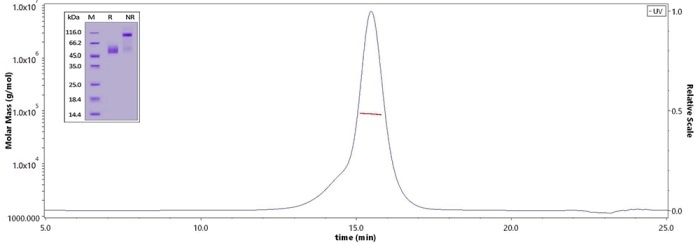
Figure 1. Human CD3E&CD3D Heterodimer Protein (Cat. No. CDD-H52Wa) on SDS-PAGE under reducing (R) and non-reducing (NR) condition and the purity of the protein is greater than 95%. The purity of the protein is more than 85% and around 80–90 kDa verified by SEC-MALS. Image Credit: ACROBiosystems
High binding ability and low batch-to-batch variations
Such validated authentic 1:1 heterodimer proteins exhibit high bioactivity in various applications. The products are homogenous with rigorous quality control to ensure the least batch-to-batch variations.

Figure 2. Immobilized Biotinylated Human CD3E&CD3D Heterodimer Protein, His, Avitag&Tag Free (Cat. No. CDD-H82W6) at 1 μg/mL (100 μL/well) on Streptavidin (Cat. No. STN-N5116) precoated (0.5 μg/well) plate, can bind Monoclonal Anti-Human CD3 Antibody, Mouse IgG2a (Cat. No. CDE-M120a) with a linear range of 0.2–6 ng/mL (QC tested), and batch differences EC50 < 0.0001 μg/mL. Image Credit: ACROBiosystems
Designed for different applications of drug development
Such products are appropriate for several applications at various stages of drug development, like antibody immunotiter detection, antibody screening, biopanning, affinity characterization and clinical pharmacokinetic assays.
Application 1: Development and screening of antibody drugs
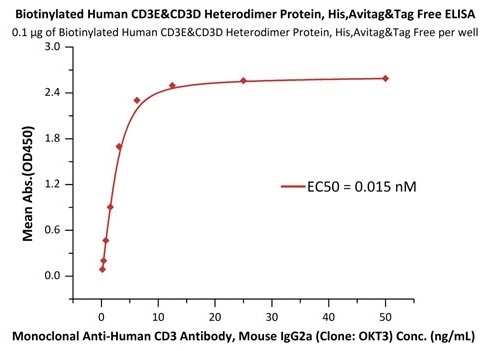
Figure 3. Immobilized Biotinylated Human CD3E&CD3D Heterodimer Protein, His, Avitag&Tag Free (Cat. No. CDD-H82W6) at 1 μg/mL (100 μL/well) on streptavidin precoated (0.5 μg/well) plate, can bind Monoclonal Anti-Human CD3 Antibody, Mouse IgG2a (Cat. No. CDE-M120a) with a linear range of 0.2–6 ng/mL. Image Credit: ACROBiosystems
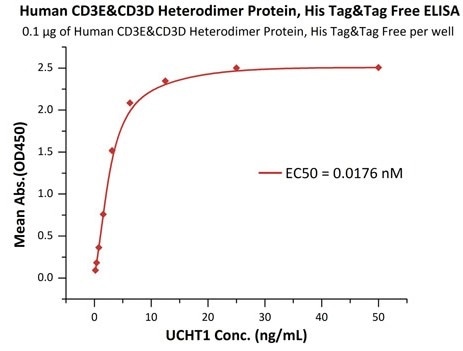
Figure 4. Immobilized Human CD3E&CD3D Heterodimer Protein, His Tag&Tag Free (Cat. No. CDD-H52W1) at 1 μg/mL (100 μL/well) can bind Anti-CD3 antibody with a linear range of 0.2–6 ng/mL. Image Credit: ACROBiosystems
Application 2: Identification and quality control of antibody drugs
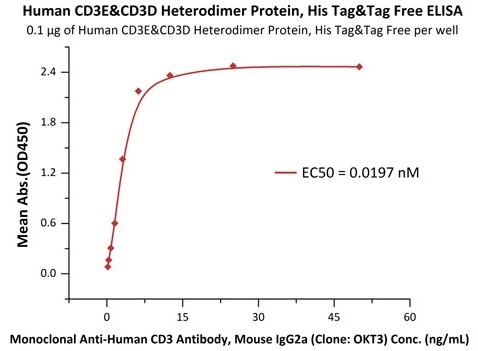
Figure 5. Immobilized Human CD3E&CD3D Heterodimer Protein, His Tag&Tag Free (Cat. No. CDD-H52W1) at 1 μg/mL (100 μL/well) can bind Monoclonal Anti-Human CD3 Antibody, Mouse IgG2a (Cat. No. CDE-M120a) with a linear range of 0.2–6 ng/mL. Image Credit: ACROBiosystems
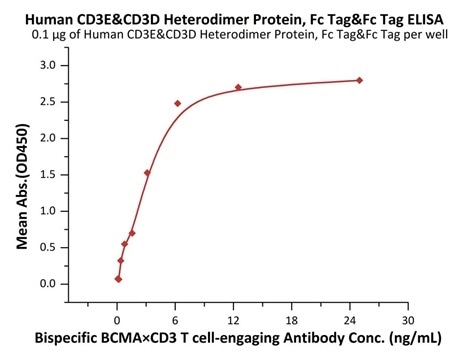
Figure 6. Immobilized Human CD3E&CD3D Heterodimer Protein, Fc Tag&Fc Tag (Cat. No. CDD-H5255) at 1 μg/mL (100 μL/well) can bind Bispecific BCMA×CD3 T cell-engaging Antibody with a linear range of 0.8–6 ng/mL. Image Credit: ACROBiosystems
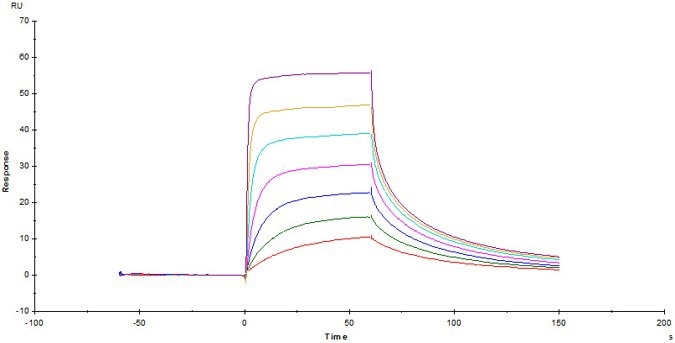
Figure 7. Biotinylated Human CD3E&CD3D Heterodimer Protein, His, Avitag&Tag Free (Cat. No. CDD-H82W6) captured on Biotin CAP - Series S sensor Chip can bind Anti-Human CD3 Antibody, Mouse IgG2a with an affinity constant of 22.5 nM as determined in an SPR assay (Biacore T200). Image Credit: ACROBiosystems
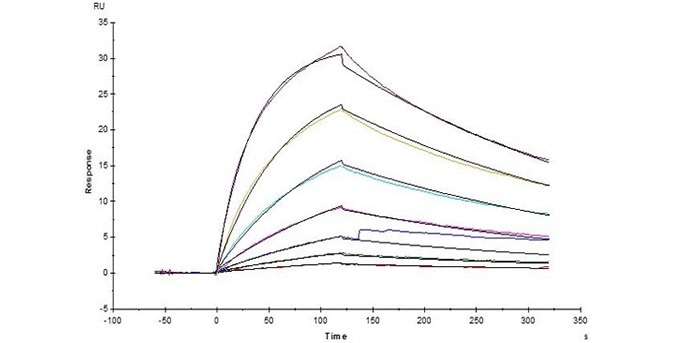
Figure 8. Bispecific T-cell Engager (CD3 X BCMA) immobilized on CM5 Chip can bind Human CD3E&CD3D Heterodimer Protein, His Tag&Tag Free (Cat. No. CDD-H52W1) with an affinity constant of 31.8 nM as determined in an SPR assay (Biacore T200). Image Credit: ACROBiosystems
Application 3: Clinical PK assay

Figure 9. Immobilized Human BCMA, His Tag (Cat. No. BCA-H522y) at 2 μg/mL, add increasing concentrations of Bispecific T cell Engager (CD3 X BCMA) in 10% human serum and then add Biotinylated Human CD3E&CD3D Heterodimer Protein, His, Avitag&Tag Free (Cat. No. CDD-H82W6) at 0.2 μg/mL. Detection was performed using HRP-conjugated streptavidin with a sensitivity of 15 ng/mL. Image Credit: ACROBiosystems